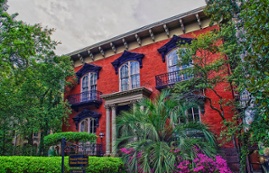No Carts Before Horses – Design for Energy Efficiency Early

 My recent visit to Savannah for the USGBC‘s green product expo charged up my historic preservation bug and got me to thinking about how to apply building science to historic buildings.
My recent visit to Savannah for the USGBC‘s green product expo charged up my historic preservation bug and got me to thinking about how to apply building science to historic buildings.
My recent visit to Savannah for the USGBC‘s green product expo charged up my historic preservation bug and got me to thinking about how to apply building science to historic buildings.
Most of us that have ever lived in, owned, or even just visited a historic home know that they are not the most comfortable places to be during the hottest and coldest times of year, even with an adapted heating and air conditioning system. They perform great in mild weather, however. In fact, they might even be more comfortable because of the “natural ventilation” of temperate air. These homes are typically very leaky, have single pane windows and little to no insulation, which all leads to drafty, uncomfortable conditions during extreme weather.
During my trip to voodoo country, I spoke with a homeowner said he was interested in the best way to “create an efficient envelope as it’s best to get that done right at the beginning.” He had hit the nail on the head, start early! In fact, start as soon as you begin to think about a new home.
Too many projects put the cart before the horse by not incorporating energy efficiency, sustainability or high performance until the project is well under way. Either it is already designed, permitted and ready to be built, the foundation is already in the ground, or the house is completely built and lived in.
 In the case of historic homes, the challenge may seem much greater than the homeowner who decides to incorporate energy efficiency when they’re starting to set the foundation. But, you see, a historic home is what it is, where a new home can be changed. And, that is where things can get messy.
In the case of historic homes, the challenge may seem much greater than the homeowner who decides to incorporate energy efficiency when they’re starting to set the foundation. But, you see, a historic home is what it is, where a new home can be changed. And, that is where things can get messy.
While the list of reasons why a project team decides to ‘Go Green or Efficient’ late in the game may be long, I can come up with a very short and maybe more compelling list of (2) reasons why not to, and one way how not to.
Why Not Reason No. 1: Change is expensive!!
OK, maybe not always. But, anyone who has been involved in the construction of a new home or an existing renovation/addition knows that at least 90% of the time a change is made mid-stream, it costs money. Even if it’s just swapping out models of a dishwasher that cost the same or less, the installation of it may be different, or it may be too big for the space in the already installed cabinets. (Changing cabinets can get really expensive!)
Another example: let’s say your home is completely designed and permitted for construction, and you’ve decided you want to make it energy efficient. One of the first things an energy efficiency consultant or green builder will recommend is a better thermal barrier (insulation). This usually includes more than just extra insulation; it also means proper installation of that insulation, and/or making it continuous. Extra insulation can be accomplished in different ways, but many times it means thicker walls. The same with continuous insulation, it can call for thickening the exterior wall assembly with rigid foam board on the outside, or using 2×6 framing instead of 2×4 to accommodate thicker insulation with higher R-value. Lastly, proper installation can mean using “raised heel trusses”, which essentially raises the roofline.
All of these changes will add cost to the construction budget, for sure. They will also add cost to the design fee. For example, raising the roof may require that the building elevations and sections be re-designed in order to meet height restrictions of your neighborhood’s design guidelines. Thickening the walls (either to provide extra or continuous insulation) may effect the floor plans because originally the house was built right up to the setbacks, so you can’t add thickness to the outside, and adding it to the inside may reduce the stair width below code minimum, forcing a re-design.
Finally, let’s say you also ask the builder incorporate good air sealing techniques along with better insulation. Now, the HVAC system will likely be oversized. High performance homes require less heating and cooling. In addition, the you’ve decided to relocatethe ductwork to within conditioned space instead of the unconditioned attic (very hot up there), which requires deep floores truss between the first and second floor to house the duct system. Because the first floor already has a low (8’-0”) ceiling height, you decide to move the 2nd floor level up to accommodate the deeper trusses. This adds an extra tread and riser to the stairs, which makes the bottom landing too small, and now you’re back to the architect to redesign the floor plan, sections, elevations, etc., etc., etc.
Is it becoming clear as mud? I hope so, because my blog software is telling me that I’m rambling on, and to wrap it up! So, I will.
“Why Not” Reason No. 2: Change takes time!!!
Need I say more? Everything I just described doesn’t happen in a vacuum, and requires hours to complete.
 “How Not” Solution No. 1: Don’t wait!!!
“How Not” Solution No. 1: Don’t wait!!!
Start early and integrate! As I mentioned above, when you think about designing your next home, make all these features as integral to the design as the number of bedroom, the architectural style and the view to ocean. The house works like a system, and requires everything to work harmoniously to perform at its best. Plus, you don’t want pay to back track.
Mercer-Williams House photo by kiraca and Cart before horse photo by emilio labrador from flickr.com, used under a Creative Commons license.
This Post Has 7 Comments
Comments are closed.

Like the article…and the
Like the article…and the title. This speaks to my roots regarding historic homes. They are a challenge, but can be improved significantly. Great pictures!!
Yes, Chris is ‘Architect Dude
Yes, Chris is ‘Architect Dude’ – a rather unique species – versed not only in all things architecture but endowed with an extraordinary complement of home performance acumen. Hopefully his example will lead to further propagation of this rare species.
:o)
Glad to see this article. A
Glad to see this article. A more humble version of the topic would include all those homes which were not designed in the first place for better energy use. The number of homeowners interested in all they can do to improve, is enormous.
Thanks, Jamie! Historic homes
Thanks, Jamie! Historic homes are a very interesting and challenging opportunity. Some say it saves energy to retrofit, others say it’s more intensive and costly. I guess it just depends on the degree to which you retrofit. The approach can make all the difference. One thing we can say, there is definitely a looooooooot of opportunity!
It was great to see you down there!
David, that means a lot
David, that means a lot coming from you. I, too, hope my example will spread. There are too more opportunities (OK, I’m overusing that word…) for just one of us to handle 🙂
David, without your help, I would not be where I am today. I owe so much of my success to you! Thank you, you are a great mentor.
M. Johnson,
M. Johnson,
You couldn’t be more correct. The opportunities (there I go again…) to improve the energy efficiency of the existing housing stock is, as you say, enormous! Doing it right in the beginning saves a lot of time, money and heartache, but doing it at all is priceless.
How to educate all of these interested homeowners is one of our GREATEST opportunities (oh, dear…), and acting on that is what we’re here to do.
Thanks for your comment.
Hi Chris,
Hi Chris,
There are a lot of great points in this article! One of the main take-aways for me is the notion that that upfront design dollars are always ‘less expensive’ than down-stream construction dollars. So its generally less costly, in the end, to invest time designing things well upfront, than fixing them later on.
Another big take-away is what you said about applying building science to older buildings. This is something I obsess over. There are great results coming out of cutting-edge building science research these days, but much of the ‘science’ is getting implemented in new construction only. I think a very fruitful undertaking would be to abstract-out the pure science and figure out strategies for applying it to older and historic homes in a manner that doesn’t compromise historic fabric (or at least, minimally, or reversibly). This is the problem domain that keeps me awake at night (only in a good way, of course!)
Anyway, great article Chris!